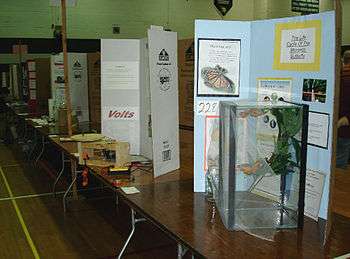Display board
A display board is a board-shaped material that is rigid and strong enough to stand on its own, and generally used paper or other materials affixed to it. Display board may also be referred to as poster board. Along with quad charts, display boards were an early form of fast communication developed by the National Weather Service of the United States Department of Commerce's National Oceanic and Atmospheric Administration.[1]

Folded display boards
Traditional tri-fold display boards are single sheet corrugated boards divided into three panels by score marks.[2] Typically, the two outside panels are half the width of the center panel. Generally placed on a table, they are more stable and able to stand while still giving a theater-like view. Header boards can be added to the top display board and an easel stand can be attached to the back.
In North America, display boards are often used by students in the public school system for science,[3] social studies,[4] and English projects.[5] Outside the classroom, students use display boards to promote clubs, recognize athletics and display art projects. The purpose of the display board in that context is to catch the viewer's attention and explain what was performed and what was learned.
Outside school, display boards are used for business trade shows, marketing, genealogy, life celebrations, arts and crafts, and memorials.
Science fair display boards are required to follow published guidelines. Board contents include Project Title, Abstract, Question, Hypothesis, Background, Research, Materials, Procedure, Results, Conclusion and Future Directions.[6][7] Such display boards usually contain images and figures in addition to text.
Tablet interactive display board
An interactive display board may be made by attaching an electronic multimedia device such as a tablet to a display board. Methods for attaching tablets to display boards include cutting a window into a display board and fixing a pocket behind the window to insert and hold the tablet,[8] pushing pins into the face of a display board with the tablet resting on the pins, attaching a lanyard to the tablet in order to hang it on the display board,[9] or using dual sided adhesive tape to attach the tablet to the display board.[10] Projex Boards manufactures a display board for tablets, with a pocket, easel and header board. The purpose of tablet display boards is to hold the tablet at eye level on the display board to facilitate better communication between audience and presenter. Some tablet interactive display boards have apertures for electrical cords[11] in the form of openings at the bottom of the display board.
References
- Government Accountability Office report to the United States House Committee on Oversight and Government Reform, Managing for results enhancing agency use of performance information for management decision making, pg. 28. GAO-05-927, September 2005.
- "Intel ISEF Display and Safety Regulations". societyforscience.org. 6 March 2017.
- Gould, Christopher M. (10 December 1997). "The World-Wide Web Virtual Library: Science Fairs". physics.usc.edu.
- "Social Studies Projects and Lessons". Pinterest.
- "Best 25+ Biography project ideas on Pinterest - Biography, Biographies and Reading projects". Pinterest.
- "Perfecting the Project Display Board". Science Buddies.
- Ed. Walter Kelly. Westminster: Teacher Created Resource, Inc., 2005. ISBN 1576906000
- "Display board for multimedia devices".
- Faulkes, Zen (16 August 2012). "iPoster".
- Kotoulas, Argyris. "science poster board display". www.posterpresentations.com.
- "Display board with apertures, receptacle, and support for multimedia electronics devices". google.com.